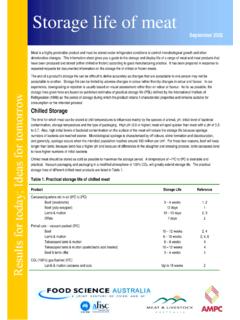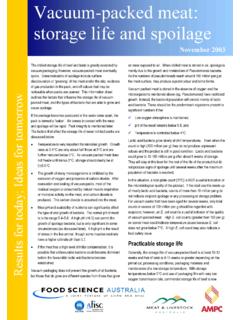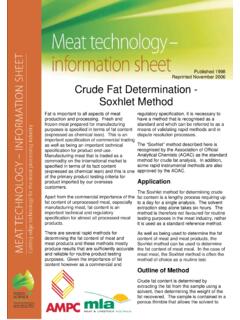Transcription of Meat technology update - meatupdate.csiro.au
1 The previous meat technology update (Issue 5/06, October 2006) discussed the development of a brown colour in fresh meat, as a result of oxidation of the pigment myoglobin to metmyoglobin. Other undesirable colours and appearances are described in this colour may develop in meat through reaction of the meat pigment myoglobin with certain compounds. When myoglobin reacts with hydrogen sulphide (H2S), the resultant pigment is sulphmyoglobin, and when myoglobin reacts with hydrogen peroxide (H2O2), a number of pigments are produced. These pigments are green. The compounds H2S and H2O2 are produced by certain microorganisms under specific storage conditions. Sulphmyoglobin greening is associated with growth of the bacterium Pseudomonas mephitica. This organism requires low oxygen levels and pH greater than for production of hydrogen sulphide from sulphur-containing amino acids.
2 Greening is associated with poor barrier films used for vacuum packaging, which allow a small amount of oxygen into the pack. The good barrier provided by most modern films has led to sulphmyoglobin greening being quite uncommon. The organism can produce greening even if the cells are less than 5% of the total microbial population. If oxygen is absent, or the level is high, or the pH is below 6, it cannot produce hydrogen sulphide and greening will not occur. To avoid green discolouration at low oxygen levels ( in vacuum or low-oxygen MAP with some residual oxygen), high pH meats should not be used. When sulphmyoglobin green packs are opened, the green colour often disappears because the pigment is oxidised to a red green pigments result from the interaction between myoglobin and hydrogen peroxide. Their formation is favoured between pH and 6.
3 The source of the hydrogen peroxide may be bacterial, may result from the interaction of ascorbic acid (vitamin C) with the oxygen molecule of Meat technology update6/06 December 2006 MEAT technology UPDATEC utting edge technology for the meat processing industryColour defects in meat Part 2: Greening, Pinking, Browning & SpotsFigure 1: Two packs of lamb showing greening, compared with a normal pack , or may be produced by the muscle itself. Hydrogen peroxide greening has been associated with cooked cured meats under aerobic conditions. In vacuum-packaged fresh meat, the meat enzyme catalase breaks down hydrogen peroxide, so production of the green pigments is limited, and greening due to sulphmyoglobin is much more and black spotsBrown discolouration in the form of spots on fat surfaces has been attributed to the yeasts Yarrowia lipolytica (formerly Saccharomycopsis lipolytica) and Candida zeylanoides.
4 Yeasts can survive and grow on chilled meat stored in air; and in vacuum-packed meat if the oxygen transmission rate of the packaging film is too high. Brown spot was a problem on vacuum-packaged beef in the 1970s, but is a rare occurrence and moulds require oxygen to grow, and can grow at temperatures from just below zero to up to 40 C, dependent on the species. Most tolerate reduced water activity, and prefer a slightly acidic environment of pH to Yeasts and moulds survive well in chillers, and incidents of brown spot on carcasses and corresponding packaged meat have been associated with contaminated condensate dripping onto the spots may develop on frozen meat stored at 5 C for 40 days or more, and this has been associated with a number of yeasts and moulds including Cladosporium cladosporoides, Cladosporium herbarum, Penicillium hirsutum and Aureobasidium pullulans.
5 These organisms penetrate into the meat surface, and must be trimmed on cured and fermented meatsSome moulds are considered desirable in cured and fermented meats because they impart certain flavours, and assist in the fermentation process; however, some are undesirable. The mould Cladosporium causes unsightly, deep-seated black spots on cured hams, which cannot be washed off. It has strong proteolytic activity, allowing it to break down the product surface and burrow into it. Scopulariopsis causes white spots on the skin of hams, and a number of other moulds cause whiskers on fermented meats. Lightly smoking the product during curing or before packaging can help to reduce mould growth. A Gram-negative bacterium, Carnomonas nigricans, has also been found to cause black spots on cured meats. These spots begin as small rust-coloured areas which blacken over a few hours.
6 Adding sodium nitrite to the cure prevented the formation of these spots; while adding dextrose, maltose or dextrin encouraged formation. Bones and marrowThe marrow of bones contains a high proportion of blood, and when bones are cut, red blood cells may be ruptured, releasing haemoglobin which gets smeared onto the surface of the bone. Haemoglobin is the red pigment in blood, and it responds to oxidation in the same way as myoglobin. Initially, on exposure to oxygen, it is bright red, but brown methaemoglobin develops rapidly in response to low oxygen levels in packaged product. When packaged in a high oxygen-modified atmosphere ( 80% O2, 20% CO2), bones discolour significantly within 24 hours. Alternatively, if the oxygen in the gas mixture above is replaced with nitrogen, a stable purplish marrow colour will remain for 1 2 weeks at 4 C or and comminuted meatsThe colour stability of meat is partly dependent on aerobic-reducing enzymes.
7 The aerobic-reducing systems prevent browning by converting metmyoglobin back to myoglobin. When the myoglobin and reducing enzymes are contained within the muscle-cell membrane, the meat has relatively good colour meat is minced, the cell structure is disrupted (see diagram below). This increases the exposure of myoglobin to oxygen, and destroys some of the muscle s innate aerobic-reducing system. This partly explains the accelerated browning observed in minced versus whole muscle. In addition, the oxygenation of meat during mincing followed by restricted access to oxygen in the middle of a pack, creates low oxygen levels at the surface of particles. At low oxygen levels myoglobin is oxidised to metmyoglobin; but, whereas in intact meat the aerobic-reducing system is active, in minced meat the system is inactive and the meat turns brown from the inside of a pack.
8 Destruction of muscle cells by mincingDestruction of muscle cells by mincingBrown spots on beef fatBrown spots on beef fatPAGE 2 MEAT T EchnOlOGy update dEcEMbEr 2006 Figure 2: Brown spots on beef fat. Figure 3: Destruction of muscle cells by have found that antioxidants can inhibit myoglobin oxidation and improve colour stability, but are more useful in controlling other aspects of oxidation such as rancidity. For example, EDTA is an antioxidant and, although it decreases lipid oxidation and rancidity, it increases myoglobin oxidation and browning; vitamin C is an antioxidant, but it can sometimes react with meat and produce hydrogen sulphide, and cause greening. At present, such additives are not permitted in Australia. Feeding vitamin E to cattle seems to decrease lipid oxidation and myoglobin oxidation and thereby improves fresh meat colour stability and shelf life.
9 One study showed that while control packs of mince were okay up to 48 hours, those from cattle fed 500IU Vitamin E for 120 days were okay up to 67 hours, and those fed 2000IU for 120 days were okay up to 92 hours. This was in PVC overwrap displayed under fluorescent meatThe colour of frozen meat is affected by: freezing rate; storage temperature and fluctuation in temperature during storage; intensity of light during display; and method of packaging. Very slowly frozen meat is excessively dark, while meat frozen in liquid nitrogen is unnaturally pale. Such extremes are unlikely to be seen under commercial conditions, but faster freezing regimes will give a paler product than slower freezing regimes. The large variation in lightness is a result of differences in the rate of ice-crystal growth. Small crystals formed by fast freezing scatter more light than large crystals formed by slow freezing; so fast-frozen meat is opaque and pale, while slow-frozen meat is translucent and dark.
10 To optimise frozen-beef colour, fresh beef should be exposed to air for 30 minutes before freezing to allow optimum bloom to develop prior to freezing. This can result in frozen beef that is similar in appearance to fresh beef. During storage of frozen meat, if it is exposed to air, slow thawing and refreezing of the exposed surface leads to dehydration of the meat. This leads to the development of freezer burn which appears as a grey-white area on the exposed surface where the fibres of the meat are visible. Freezer burn areas stay dry and pale when the meat is defrosted, and is tough and dry to major colour problem during retail display of frozen meat is photo-oxidation. Frozen meat under direct illumination oxidises from the surface inwards (compared with fresh meat which oxidises from the subsurface outwards). Oxidation of frozen oxymyoglobin is temperature dependent the rate increases from 5 to 12 C and then decreases to a minimum at 20 C.


